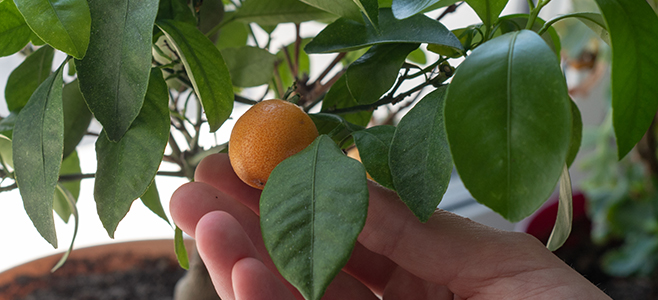
There’s something so exciting and satisfying about eating fruits and vegetables that come from your own home garden! The best part is, you don’t even need that much space in order to enjoy this feeling…many an amateur gardener has produced prize-winning tomatoes on a small balcony or savory herbs on a kitchen windowsill.
But you don’t have to stop there – many edible plants do well in small spaces, and even in indoor spaces. And that includes fruit trees – thanks to the many dwarf varieties available and with proper care, growing citrus trees on your patio or in your sunroom is easily within your reach.
Citrus Trees in the Small Garden
When grown outdoors, small fruit trees produce enough fruit for a small family throughout the harvest season, but make sure you live in a climate that doesn’t experience frigid temperatures before you plant a citrus tree in the ground.
Keeping potted dwarf citrus trees can be especially intriguing for citrus lovers who dwell in colder climates as they can be kept indoors part of the time and still produce fruit.
Dwarf Citrus Tree Varieties
It might surprise you to learn that most of your favorite citrus comes in a dwarf variety. In fact, – most standard varieties have been grafted onto dwarf or semi-dwarf rootstocks.
Grown using dwarf rootstock, such trees can be kept to as little as six feet tall while still producing full-size fruit. When kept in a suitable container, dwarf citrus trees can live in a sunny spot indoors full-time or be moved to a patio during the warmer months.
You can find popular varieties of the following dwarf citrus trees at Citrus.com. The varieties of the citrus below all grow about 8-11 feet when planted in the ground, and 4-11 feet when kept in a container:
- Dwarf Orange Trees. Citrus.com offers a variety of options for growing fresh, full-size oranges at home, from Dwarf Valencia Orange Trees (known for producing the world’s best juicing oranges) to Dwarf Washington Navel Orange Trees (which produce the classic navel everyone loves so much). You don’t need to live in Florida to enjoy homegrown oranges anymore!
- Dwarf Lime Trees. The limes grown on a dwarf lime tree can be used for juice, cooking, zest, or any recipe that requires fresh lime. Imagine making Key Lime Pie with your own limes whenever you like! If you’re looking for lime flavor similar to what you’d find in the grocery store, go with a Persian ( Bearrs) Lime Trees. Love cooking ethnic dishes? The Kaffir Lime Tree produces a spicier fruit.
- Dwarf Lemon Trees. Dwarf lemon trees are easy to grow, making them a great choice for small or indoor gardens. They’re also a great choice for smaller families who love to cook or make drinks from fresh lemons, but don’t want to buy a whole back at the grocery store. Meyer Lemon Trees produce year-round, while Eureka Lemon Trees are less sweet like the lemons you find in stores. Both make delicious lemonade!
- Dwarf Kumquat Trees. Have you ever tried a kumquat? If you haven’t, you should – these easy-to-eat fruits are small and don’t even need to be peeled – just pop them whole into your mouth like a grape!
- Dwarf Mandarin Trees. If you’re a fan of small, sweet, easy-to-peel tangerines, Clementines, Satsumas and other mandarin varieties, a dwarf mandarin tree is a great choice. The tree may be small, but the fruit it will put out is the same that’s been pleasing kids for ages!
- Dwarf Grapefruit Trees. Do you love a half of delicious, sweet red grapefruit for breakfast, or a glass of refreshing, healthy grapefruit juice? Dwarf grapefruit trees may be small, but they produce full-size versions of the nutritional powerhouse fruit just like their larger cousins!
- Dwarf Lemon Lime Tree. Also known as cocktail trees, Dwarf Lemon Lime Trees let you grow two fruits where you might normally grow one! Even more space-saving than other dwarf citrus trees, cocktail trees are grafted to grow lemons and limes on the same tree.
Citrus.com also offers several varieties of dwarf citrus trees that can be kept in hanging baskets (though these will likely be more ornamental than fruit-bearing)!
Caring For Dwarf Citrus Trees
Once you’ve bought your tree and planted it in a large pot with specially formulated citrus soil and plenty of drainage, select a spot for it to live that will get at least six to eight hours of direct sunlight, away from a dry air vent.
When grown in a container, citrus trees prefer periodic deep watering over frequent, light doses. Deep watering promotes deeper root growth and strengthens your tree. Allowing a few to several days between watering lets the soil drain properly. It’s fine to allow the top of the soil to dry out.
Applying a fertilizer helps to replenish the nutrients your growing tree leaches from its soil over time. To ensure you get a good crop of fruit, be sure to use a specially formulated fertilizer for citrus trees in pots. You can find the best fertilizer for citrus trees in containers from Citrus.com – in fact, our All-in-One Kits include everything you need to ensure your tree’s optimum health.
To keep your tree healthy and productive, remove all suckers after harvest and prune away any dead tree branches or branches that cross one another. If the upper canopy becomes thick to the point that the lower branches don’t get enough light, you’ll probably want to thin it.

